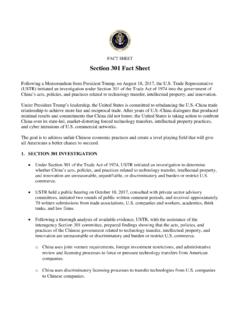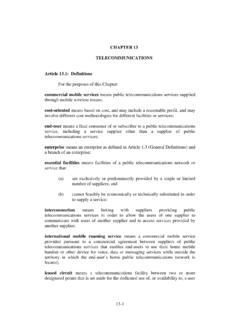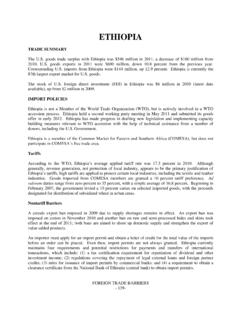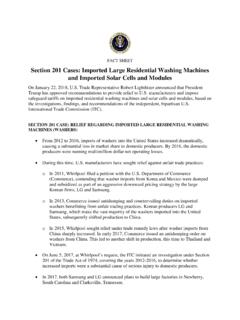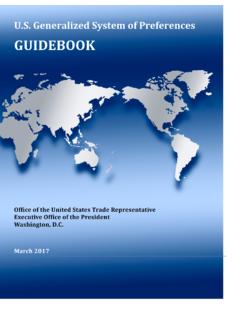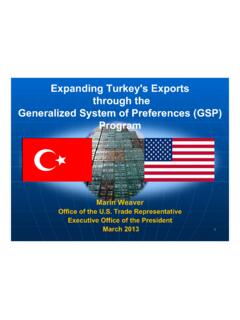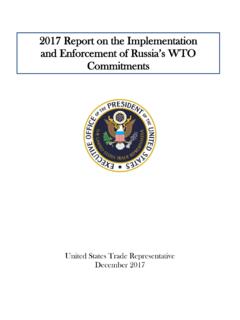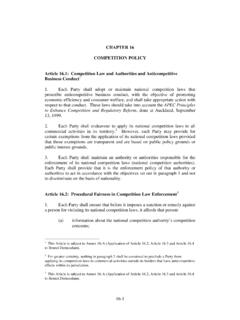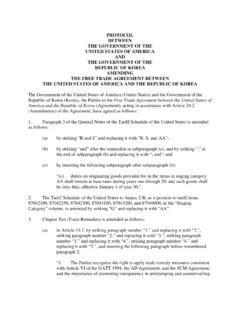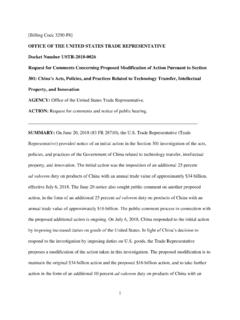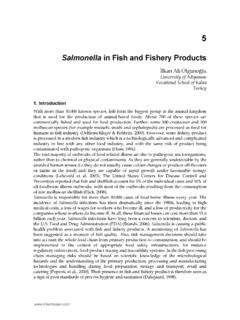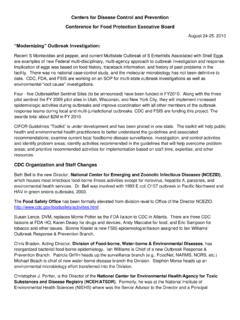Transcription of 2013 REPORT ON SANITARY AND PHYTOSANITARY …
1 2013 REPORT ON SANITARY AND PHYTOSANITARY MEASURESUNITED STATES TRADE REPRESENTATIVE2013 REPORT on SANITARY and PHYTOSANITARY Measures Ambassador Demetrios MarantisOffice of the United States Trade Representative ACKNOWLEDGEMENTS The Office of the United States Trade Representative (USTR) is responsible for the preparation of this REPORT . In preparing the REPORT , USTR solicited substantial information from embassies and from interested stakeholders. USTR gratefully acknowledges in particular the contributions of all government staff who contributed to the drafting and review of this REPORT . Appreciation is extended to the Executive Branch agencies, including the Environmental Protection Agency, the Food and Drug Administration, and the Departments of Agriculture, Commerce, and State, for their important contributions and assistance. Finally, special thanks go to all Federal employees who work every day to resolve SANITARY and PHYTOSANITARY trade barriers, helping to expand food and agricultural exports around the world.
2 March 2013 LIST OF FREQUENTLY USED ACRONYMS AND ABBREVIATIONS AI Avian Influenza APEC Asia Pacific Economic Cooperation APHIS USDA's Animal and Plant Health Inspection Service AQSIQ China s General Administration of Quality Supervision, Inspection, and Quarantine ASEAN Association of Southeast Asian Nations BAPHIQ Taiwan s Bureau of Animal and Plant Health Inspection and Quarantine BiH Bosnia and Herzegovina BSE Bovine Spongiform Encephalopathy CAFTA-DR Dominican Republic-Central America-United States Free Trade Agreement CAN Andean Community CARICOM Caribbean Community COMESA Common Market for Eastern and Southern Africa Codex Codex Alimentarius Commission COFEPRIS Federal Commission for the Protection against SANITARY Risk (Mexico) CTPA Colombia Trade Promotion Agreement CU Customs Union of the Russian Federation, Kazakhstan.
3 And Belarus EEC European Economic Commission EPA Environmental Protection Agency EFSA European Food Safety Authority EU European Union FAO United Nations Food and Agriculture Organization FAS USDA s Foreign Agricultural Service FDA Food and Drug Administration FMD Foot and Mouth Disease FSIS USDA s Food Safety and Inspection Service FTA Free Trade Agreement GE Genetically Engineered HPAI Highly Pathogenic Avian Influenza IFSTL International Food Safety Training Laboratory IICA Inter-American Institute for Cooperation on Agriculture IPPC International Plant Protection Convention JCCT Joint Commission for Commerce and Trade JIFSAN Joint Institute for Food Safety and Applied Nutrition LL601 Liberty Link 601 LMO Act Korea s Living Modified Organisms Act LPAI Low Pathogenic Avian Influenza MAPA Brazil s Ministry of Agriculture, Livestock and Food Supply MARA Turkey s Ministry of Agriculture and Rural Affairs MOU Memorandum of Understanding MRL Maximum Residue Limit MT Metric ton NAFTA North American Free Trade Agreement NAPPO North American Plant Protection Organization NEI National Export Initiative NOAA National Oceanic and Atmospheric Administration NTE National Trade Estimate REPORT on Foreign Trade Barriers OIE World Organization for Animal Health PMWS Post-Weaning Multisystemic Wasting Syndrome PRA Pest Risk Assessment PRRS Porcine Reproductive and Respiratory Syndrome PRT Pathogen Reduction Treatment RABESA Regional Biotechnology Framework SADC South African Development Community SCC Somatic cell count SENASICA Services for the National Health for Food Safety and Food Quality (Mexico)
4 SPS SANITARY and PHYTOSANITARY SPS Agreement WTO Agreement on the Application of SANITARY and PHYTOSANITARY Measures SPS Committee WTO Committee on SANITARY and PHYTOSANITARY Measures SRM Specified Risk Material STDF Standards and Trade Development Facility TBT Technical Barriers to Trade TBT Agreement WTO Agreement on Technical Barriers to Trade TIFA Trade and Investment Framework Agreement T&L Traceability and Labeling TPP TransPacific Partnership TPSC Trade Policy Staff Committee TRQ Tariff Rate Quota TWG Trade Working Group USAID Agency for International Development USDA Department of Agriculture USTR Office of the Trade Representative WHO World Health Organization WTO World Trade Organization FOREWORD I. The Office of the United States Trade Representative (USTR) is pleased to publish its fourth annual REPORT on SANITARY and PHYTOSANITARY Measures (SPS REPORT ).
5 This REPORT was created to respond to the concerns of farmers, ranchers, manufacturers, and workers who confront SANITARY and PHYTOSANITARY (SPS) trade barriers as they seek to export high-quality American food and agricultural products globally. SPS measures are rules and procedures that governments use to ensure that foods and beverages are safe to consume and to protect animals and plants from pests and diseases. Many SPS measures are fully justified, but too often governments cloak discriminatory and protectionist trade measures in the guise of ensuring human, animal, or plant safety. These SPS barriers not only harm farmers, ranchers, manufacturers, workers, and their families, they also deprive consumers around the world of access to high-quality American food and agricultural goods. USTR is committed to identifying and combating unwarranted SPS barriers to food and agricultural exports.
6 USTR s efforts to remove unwarranted foreign SPS barriers serve the President s goal of doubling exports by the end of 2014 through the National Export Initiative. The United States achieved some important successes since the publication of last year s REPORT in dismantling SPS barriers that blocked agricultural exports. For example, negotiators removed specific SPS barriers in El Salvador, Hong Kong, Japan, and Mexico for exports of beef; worked with Taiwan to implement a maximum residue limit (MRL) for beef containing ractopamine; successfully petitioned the European Union to allow the use of a pathogen reduction treatment on beef; resolved barriers for rough (paddy) rice and poultry products for export to Colombia; improved the import procedures for cherries entering Korea; and gained access for certain pears into China. In 2013, USTR will continue to work with colleagues from across the Government, as well as interested stakeholders, to encourage other governments to remove their unwarranted SPS measures.
7 As always, we will engage other governments in all available bilateral, regional, and multilateral fora as part of our efforts to dismantle these barriers to food and agricultural exports and strengthen the rules-based trading system to ensure a level playing field abroad for ranch and farm products. We look forward to making further progress on behalf of America s farmers, ranchers, manufacturers, and workers, as well as families who depend on export-supported American jobs. Ambassador Demetrios Marantis Acting Trade Representative March 2013 i TABLE OF CONTENTS I. EXECUTIVE SUMMARY .. 1 II. INTRODUCTION .. 3 A. Genesis of This 3 B. SPS Measures What They Are, Why They Are Needed, and When They Become Trade Barriers .. 4 C. The World Trade Organization Agreement on the Application of SANITARY and PHYTOSANITARY Measures .. 5 D. Other SPS-Related International Agreements .. 9 E.
8 International Standard Setting Bodies .. 10 F. Government 11 G. Sources of Information about SPS Trade Barriers .. 13 H. Government Engagement on Foreign SPS Trade Barriers .. 14 III. MAJOR CROSS-CUTTING SPS ISSUES .. 19 A. Export Certification Requirements .. 19 B. Biotechnology .. 21 C. Bovine Spongiform Encephalopathy .. 22 D. Avian Influenza .. 23 E. Maximum Residue Levels for Pesticides .. 24 IV. COUNTRY REPORTS .. 27 ARGENTINA .. 28 AUSTRALIA .. 29 BAHRAIN .. 31 ii BOLIVIA .. 31 BOSNIA AND HERZEGOVINA .. 32 BRAZIL .. 32 CHILE .. 33 CHINA .. 34 COLOMBIA .. 38 CROATIA .. 40 DOMINICAN REPUBLIC .. 40 ECUADOR .. 40 EGYPT .. 41 EL SALVADOR .. 42 ETHIOPIA .. 42 EUROPEAN UNION .. 43 INDIA .. 53 INDONESIA .. 55 56 JAMAICA .. 57 JAPAN .. 57 KAZAKHSTAN .. 60 62 KOREA .. 62 KUWAIT .. 64 KYRGYZSTAN .. 65 iii MACEDONIA .. 65 MALAYSIA .. 65 MEXICO .. 65 MOROCCO .. 68 NEW 68 68 PERU .. 69 PHILIPPINES.
9 70 RUSSIA .. 70 SAUDI ARABIA .. 75 SERBIA .. 75 SINGAPORE .. 75 SOUTH 76 SOUTH AFRICAN DEVELOPMENT COMMUNITY .. 77 SRI LANKA .. 77 SWITZERLAND .. 78 TAIWAN .. 78 THAILAND .. 81 TURKEY .. 82 83 84 VIETNAM .. 85 iv V. TECHNICAL ASSISTANCE .. 89 APPENDIX .. 97 1 I. EXECUTIVE SUMMARY The 2013 REPORT on SANITARY and PHYTOSANITARY Measures (SPS REPORT ) is a specialized REPORT dedicated to describing significant barriers to food, farm, and ranch exports arising from measures that foreign governments apply on the grounds that such measures are necessary to protect human, animal, or plant life or health from risks arising from the entry or spread of plant- or animal-borne pests or diseases, or from additives, contaminants, toxins, or disease-causing organisms in foods, beverages, or feedstuffs. These measures, known in World Trade Organization (WTO) parlance as SANITARY and PHYTOSANITARY (SPS) measures, play an increasingly critical role in shaping the flow of global trade.
10 The United States strongly supports the right of governments through robust regulatory frameworks to protect their people, animals, and plants from health risks of this kind. This REPORT focuses on SPS measures that appear to be unscientific, unduly burdensome, discriminatory, or otherwise unwarranted and create significant barriers to exports. Many of these measures can present particular challenges for small and medium sized enterprises that typically lack the resources to identify and address such barriers. This REPORT is intended to describe and advance efforts to identify and eliminate these unwarranted measures. Section II of this REPORT presents an overview of SPS measures, describes the relevant international agreements governing these measures, and discusses the and international mechanisms for addressing them. In particular, section II covers the following topics: (1) the genesis of this REPORT ; (2) the growing importance of SPS measures in global trade; (3) rules governing SPS measures under the WTO s Agreement on the Application of SANITARY and PHYTOSANITARY Measures (SPS Agreement); (4) rules and mechanisms regarding SPS measures in free trade agreements (FTAs); (5) international standard setting in the SPS area; (6) the role of various Government agencies in addressing SPS-related trade issues; (7) sources of information about SPS trade barriers; and (8) trade policy mechanisms for considering and addressing SPS measures, including bilateral engagement and WTO dispute settlement.
